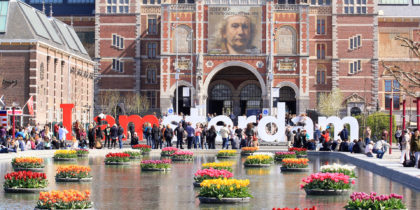Rijksmuseum. Van Gogh Museum. Anne Frank House. Rembrandt House. The answer to, “What museums did you see in Amsterdam?” almost always includes these world-famous sites. And like most visitors, you’re probably going to, and should, hit up some of Amsterdam’s most famous museums, like the Van Gogh Museum. But how about trying something a bit different?
A visit to a museum that won’t (but should) be on every other tourist’s checklist will let you drop some actual knowledge on your friends back home and give you a taste of life in Amsterdam during the Dutch Golden Age — not to mention the answer to a question you may never have known you had: Can you hide an entire, full-sized church in plain sight? The answer: Yes, you can.
As always, make sure to check for travel guidelines and closures before planning your trip.
The Big Reveal
Head to the Red Light District (De Wallen) to visit Amsterdam’s second-oldest museum, the Museum Ons’ Lieve Heer op Solder (Our Lord in the Attic Museum), formerly Museum Amstelkring. Prepare to be a bit blown away, and bonus: finally get a look inside one of those beautiful canal houses you’ve been passing by.
It might seem a bit odd to go looking for a church on one of the main streets in the Red Light District — not exactly where one would expect to find a hidden church. But the Red Light District is a study in contrasts, still a bit salacious but steeped in history.
Case in point: in the 17th century, when Catholicism could not be publicly practiced in the Netherlands, a Catholic merchant named Jan Hartman most certainly did. And not, like, a room or two tucked away somewhere — a whole entire church.
In 1660 he purchased a grand townhouse, and two houses behind it, with a plan to build a church spanning the top floors of the buildings. Because as long as Catholic worship took place out of view, authorities, in the great tradition of Dutch tolerance, simply looked the other way. And that they did: The church served as the local parish until 1887.
And the church was certainly out of view — all that could be seen from the street was Hartman’s grand canal house. This once-hidden marvel is about to be the source of your day’s delight.
Hidden No More
Visits begin in the entrance building at number 38, which houses a café and gift shop. Visitor’s can choose audio-tour devices if they wish, offered in many languages, and then make their way via belowground hallway to the original canal house at number 40.
As you make your way up through the canal house to the church, you are treated to a faithfully restored look at life in 17th-century Amsterdam. The Reception Hall, in Dutch classicist style, exudes a feeling of wealth, from the black-and-white marble floors to the grand windows and ornate coffered ceiling.
It stands in contrast to the Day Room, the Harman family’s living room, with its wide plank floors and warm feeling.
You’ll also get a look at a 17th-century kitchen with original, blue-painted Delft tiles (take a close look at the different figures in the tiles) as well as the Second Dwelling in the Alley, which housed the church’s priest. Pay attention to the bed tucked into the cupboard; it’s certainly cozy.
Moving on Up
Climbing the steep, somewhat winding staircase, passing a tiny room tucked behind the stairs, make your way toward the church entrance. Emerging at the top, you’ll find yourself in a church that is so large — and so complete — it’s hard to believe you didn’t walk in from outside.
It’s a true wow moment. It might even take your breath away.
The space is soaring, with a second-story gallery overlooking the main floor and dusty-pink hued woodwork. The pink hue perfectly accents the floor-to-ceiling, gold-accented, marble-columned Baroque altar.
The altarpiece, painted by Jacob de Wit in 1716, is called the “Baptism of Christ.” (You can see de Wits’ chalk and pen study for it at the museum, as well.) Above that, admire the gilt and plaster-relief sculptures on the ceiling.
Poke around the second story and check out the custom-made organ at the back of the church; it’s still in use. Back downstairs, look behind the altar to find the Our Lady Chapel with its statue of the Virgin Mary dating back to about 1690 and restored in 2013.
Marvel at the recreated, period-correct rush matting on the floor. Take a seat and drink it all in. It might be quite a long time before you again come across something this surprisingly delightful.




